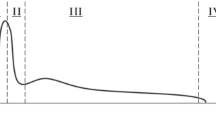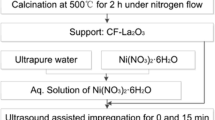Abstract
Catalyzed thermal decomposition of methane to produce hydrogen was studied. The carbon microfibers with embedded Ni, Cu and Co metals and metal phosphides were introduced as the novel catalysts. The catalysts were prepared by needle-less electrospinning being a versatile method for fibers production in large scale. The efficiency of methane decomposition by utilization of micro fiber carbon supported metal catalysts was studied by the pyrolysis-capillary gas chromatography method. The experiment was carried out in the temperature range from 973.15 to 1073.15 K. Kinetic parameters were calculated based on the Demitcheli kinetic model. It was found that the morphology, schedule of heat treatment and type and content of incorporated transition metals and metal phosphides may be the controlling parameter in the catalytic decomposition of methane. The highest conversion rates about 54% were achieved using carbon microfibers doped with cobalt and cobalt phosphide nanoparticles. The catalyst was heat treated in argon atmosphere followed by the hydrogen reduction. The second highest conversion rates were achieved with carbon microfibers doped with nickel and nickel phosphide nanoparticles carbonized only under argon atmosphere.
Graphic Abstract














Similar content being viewed by others
References
Colmati F, Alonso CG, Martins TD et al (2018) Production of hydrogen and their use in proton exchange membrane fuel cells. Adv Hydrog Gener Technol. https://doi.org/10.5772/intechopen.76663
Zhou L, Enakonda LR, Harb M et al (2017) Fe catalysts for methane decomposition to produce hydrogen and carbon nano materials. Appl Catal B 208:44–59. https://doi.org/10.1016/j.apcatb.2017.02.052
Syed Muhammad ad AF, Awad A, Saidur R et al (2018) Recent advances in cleaner hydrogen productions via thermo-catalytic decomposition of methane: admixture with hydrocarbon. Int J Hydrog Energy. https://doi.org/10.1016/j.ijhydene.2018.08.091
Zhou L, Enakonda LR, Li S et al (2018) Iron ore catalysts for methane decomposition to make COx free hydrogen and carbon nano material. J Taiwan Inst Chem Eng 87:54–63. https://doi.org/10.1016/j.jtice.2018.03.008
Zhou L, Harb M, Hedhili MN et al (2017) Microemulsion prepared Ni 88 Pt 12 for methane cracking. RSC Adv 7:4078–4082. https://doi.org/10.1039/C6RA25069F
Zhou L, Enakonda LR, Saih Y et al (2016) Catalytic methane decomposition over Fe-Al2 O3. Chemsuschem 9:1243–1248. https://doi.org/10.1002/cssc.201600310
Zhou L, Basset JM (2016) Unsupported NiPt alloy metal catalysts prepared by water-in-oil (W/O) microemulsion method for methane cracking. Fuel 181:805–810. https://doi.org/10.1016/j.fuel.2016.05.067
Reshetenko TV, Avdeeva LB, Ushakov VA et al (2004) Coprecipitated iron-containing catalysts (Fe-Al2O3, Fe-Co-Al2O3, Fe-Ni-Al2O3) for methane decomposition at moderate temperatures: part II. Evolution of the catalysts in reaction. Appl Catal A 270:87–99. https://doi.org/10.1016/j.apcata.2004.04.026
C Deniz, N Karatepe (2013) Hydrogen and carbon nanotube production via catalytic decomposition of methane. In: Proceedings of the Carbon Nanotubes, Graphene, and Associated Devices, vol 8814, SPIE. https://doi.org/10.1117/12.2023968
Torres D, De Llobet S, Pinilla JL et al (2012) Hydrogen production by catalytic decomposition of methane using a Fe-based catalyst in a fluidized bed reactor. J Nat Gas Chem 21:367–373. https://doi.org/10.1016/S1003-9953(11)60378-2
Li Y, Zhang B, Xie X et al (2006) Novel Ni catalysts for methane decomposition to hydrogen and carbon nanofibers. J Catal 238:412–424. https://doi.org/10.1016/j.jcat.2005.12.027
Takenaka S, Kobayashi S, Ogihara H, Otsuka K (2003) Ni/SiO2catalyst effective for methane decomposition into hydrogen and carbon nanofiber. J Catal 217:79–87. https://doi.org/10.1016/S0021-9517(02)00185-9
Wang G, Jin Y, Liu G, Li Y (2013) Production of hydrogen and nanocarbon from catalytic decomposition of methane over a Ni-Fe/Al2O3 catalyst. Energy Fuels 27:4448–4456. https://doi.org/10.1021/ef3019707
Dunker AM, Kumar S, Mulawa PA (2006) Production of hydrogen by thermal decomposition of methane in a fluidized-bed reactor—effects of catalyst, temperature, and residence time. Int J Hydrog Energy 31:473–484. https://doi.org/10.1016/j.ijhydene.2005.04.023
Muradov N (2001) Catalysis of methane decomposition over elemental carbon. Catal Commun 2:89–94. https://doi.org/10.1016/S1566-7367(01)00013-9
Urdiana G, Valdez R, Lastra G et al (2018) Production of hydrogen and carbon nanomaterials using transition metal catalysts through methane decomposition. Mater Lett 217:9–12. https://doi.org/10.1016/j.matlet.2018.01.033
Christian B, Lødeng R, Holmen A (2008) A review of catalytic partial oxidation of methane to synthesis gas with emphasis on reaction mechanisms over transition metal catalysts. Appl Catal A 346:1–27. https://doi.org/10.1016/j.apcata.2008.05.018
Zhang L, Aboagye A, Kelkar A (2014) A review: carbon nanofibers from electrospun polyacrylonitrile and their applications. J Mater Sci 49:463–480. https://doi.org/10.1007/s10853-013-7705-y
Inagaki M, Yang Y, Kang F (2012) Carbon nanofibers prepared via electrospinning. Adv Mater 24:2547–2566. https://doi.org/10.1002/adma.201104940
Garg K, Bowlin GL, Garg K, Bowlin GL (2014) Electrospinning jets and nanofibrous structures. Biomicrofluidics 5:013403. https://doi.org/10.1063/1.3567097
Liu W, Zhang H, Li D et al (2013) Study on needle and needleless electrospinning for nanofibers. Adv Mater Res 752:276–279. https://doi.org/10.4028/www.scientific.net/AMR.750-752.276
Jirsak O, Petrik S (2015) Recent advances in nanofibre technology: needleless electrospinning. Int J Nanotechnol 9:8–9. https://doi.org/10.1504/IJNT.2012.046756
Streckova M, Orinakova R, Mudra E et al (2018) Design of electroactive carbon fibers decorated with metal and metal-phosphide nanoparticles for hydrogen evolution technology. Energy Technol 6:1310–1331. https://doi.org/10.1002/ente.201700879
Tang Yufeng, Huang Fugiang, Zhao Wei, Liu Zhangiang, Wan Dongyun (2012) Synthesis of graphene-supported Li4Ti5O12 nanosheets for high rate battery application. J Mater Chem 22:11257–11260. https://doi.org/10.1039/c2jm30624g
Wang L, Lachawiec AJ, Yang RT (2013) Nanostructured adsorbents for hydrogen storage at ambient temperature: high-pressure measurements and factors in fluencing hydrogen spillover. RSC Adv 3:23935–23952. https://doi.org/10.1039/c3ra44216k
Syed Muhammad ad AF, Awad A, Saidur R et al (2018) Recent advances in cleaner hydrogen productions via thermo-catalytic decomposition of methane: admixture with hydrocarbon. Int J Hydrog Energy 43:18713–18734. https://doi.org/10.1016/j.ijhydene.2018.08.091
Suelves I, Pinilla JL, Lázaro MJ et al (2009) Effects of reaction conditions on hydrogen production and carbon nanofiber properties generated by methane decomposition in a fixed bed reactor using a NiCuAl catalyst. J Power Sour 192:35–42. https://doi.org/10.1016/j.jpowsour.2008.11.096
Muradov N, Smith F, T-Raissi A (2005) Catalytic activity of carbons for methane decomposition reaction. Catal Today 102–103:225–233. https://doi.org/10.1016/j.cattod.2005.02.018
Dufour A, Celzard A, Ouartassi B et al (2009) Effect of micropores diffusion on kinetics of CH4 decomposition over a wood-derived carbon catalyst. Appl Catal A 360:120–125. https://doi.org/10.1016/j.apcata.2009.02.033
Demicheli MC, Ponzi EN, Ferretti OA, Yeramian AA (1991) Kinetics of carbon formation from CH4-H2mixtures on nickel-alumina catalyst. Chem Eng J 46:129–136. https://doi.org/10.1016/0300-9467(91)87004-T
Kuvshinov GG, Mogilnykh YI, Kuvshinov DG (1998) Kinetics of carbon formation from CH4-H2mixtures over a nickel containing catalyst. Catal Today 42:357–360. https://doi.org/10.1016/S0920-5861(98)00115-1
Borghei M, Karimzadeh R, Rashidi A, Izadi N (2010) Kinetics of methane decomposition to COx-free hydrogen and carbon nanofiber over Ni-Cu/MgO catalyst. Int J Hydrog Energy 35:9479–9488. https://doi.org/10.1016/j.ijhydene.2010.05.072
Moliner R, Suelves I, Lázaro MJ, Moreno O (2005) Thermocatalytic decomposition of methane over activated carbons: influence of textural properties and surface chemistry. Int J Hydrog Energy 30:293–300. https://doi.org/10.1016/j.ijhydene.2004.03.035
Presland AEB, Walker PL Jr (1969) Growth of single-crystal graphite by pyrolysis of acetylene. Carbon 7:1–4. https://doi.org/10.1016/0008-6223(69)90002-5
Baird T, Fryer JR, Grant B (1974) Carbon formation on iron and nickel foils by hydrocarbon pyrolysis- reactions at 700°C. Carbon 12:591–602. https://doi.org/10.1016/0008-6223(74)90060-8
Li Y, Li D, Wang G (2011) Methane decomposition to COx -free hydrogen and nano-carbon material on group 8–10 base metal catalysts: a review. Catal Today 162:1–48. https://doi.org/10.1016/j.cattod.2010.12.042
Konieczny A, Mondal K, Wiltowski T, Dydo P (2008) Catalyst development for thermocatalytic decomposition of methane to hydrogen. Int J Hydrog Energy 33:264–272. https://doi.org/10.1016/j.ijhydene.2007.07.054
Acknowledgements
This work was supported by the Scientific Grant Agency of the Ministry of Education, Science, Research, and Sport of the Slovak Republic Projects No. VEGA 1/0074/17, and Slovak Research and Development Agency under the Contract No. APVV 16-0029.
Author information
Authors and Affiliations
Corresponding author
Additional information
Publisher's Note
Springer Nature remains neutral with regard to jurisdictional claims in published maps and institutional affiliations.
Rights and permissions
About this article
Cite this article
Sisáková, K., Oriňak, A., Oriňaková, R. et al. Methane Decomposition Over Modified Carbon Fibers as Effective Catalysts for Hydrogen Production. Catal Lett 150, 781–793 (2020). https://doi.org/10.1007/s10562-019-02962-w
Received:
Accepted:
Published:
Issue Date:
DOI: https://doi.org/10.1007/s10562-019-02962-w




